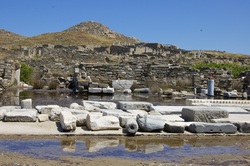
A few Gators took a ferry Saturday from Mykonos to the nearby island of Delos, scene of the most amazing set of ancient ruins I've seen after Pompeii.
Aside from a couple of houses for the roughly dozen residents, a museum and a cafe, the entire island is nothing but ruins. Unlike Pompeii, the ruins are in disarray, with many of the structures having been plundered for their marble and stones centuries ago. But the island is remarkable to see today, and it has a rich past.
Delos, whose history stems from 3,400 years ago, was a spiritual center of the Greek islands. Zeus had a temple here. Nearby islands kept their temple treasuries on Delos, making it a Fort Knox of its day, in the words of Rick Steves. Some 30,000 people called it home, until a warring king devastated the island in a surprise attack.
Little of Zeus' temple remains atop the highest point on the island. In fact, nothing is whole is most of what remains are partial walls and a few mosaics. Lots of goodies have been carted off the National Archeology Museum in Athens. Still, you get a sense of life here. Shells of some of the 3,000 shops and thousands of homes remain. The fact that walls still stand speaks to the careful craftsmanship of the early Greek builders, who didn't need zoning laws to produce a sound structure.
See pictures for more.
Aside from a couple of houses for the roughly dozen residents, a museum and a cafe, the entire island is nothing but ruins. Unlike Pompeii, the ruins are in disarray, with many of the structures having been plundered for their marble and stones centuries ago. But the island is remarkable to see today, and it has a rich past.
Delos, whose history stems from 3,400 years ago, was a spiritual center of the Greek islands. Zeus had a temple here. Nearby islands kept their temple treasuries on Delos, making it a Fort Knox of its day, in the words of Rick Steves. Some 30,000 people called it home, until a warring king devastated the island in a surprise attack.
Little of Zeus' temple remains atop the highest point on the island. In fact, nothing is whole is most of what remains are partial walls and a few mosaics. Lots of goodies have been carted off the National Archeology Museum in Athens. Still, you get a sense of life here. Shells of some of the 3,000 shops and thousands of homes remain. The fact that walls still stand speaks to the careful craftsmanship of the early Greek builders, who didn't need zoning laws to produce a sound structure.
See pictures for more.
 RSS Feed
RSS Feed